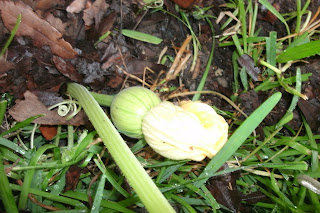This summer I decided it might be fun to try and grow pumpkins. I was more interested in a smaller pumpkin, one that would be good for eating. I picked up a packet of these seeds at Home Depot:
Small Sugar Pumpkin, an heirloom variety that produces small pumpkins around 4-5lbs each (so they say) that are good for baking.
So I made 2 small hills, and had each of my daughters, Elizabeth and Michelle (9 & 6), help me prepare the hill and they planted the seeds and watered them. I wanted to make it fun for them to see the pumpkins grow.
I planted then in early July, and the started growing fast. Here is what they looked like on July 21st.
I used the tomato cage in order to keep our dog Maggie from digging there or laying on top of the plants and killing them. It was stinkin' hot at the end of July and early August. It was over 100 degrees for over 2 weeks, some days hitting 106, but the plant handled the heat really well. They just kept on growing.
And here is what they looked like on August 4th. As you can see, the vine were starting to lay on the ground and run.
After a few more weeks, on Aug 17th, they really started spreading out and flowering too. At this time, I had read how it really helps to dig in pumpkin vines, both to encourage secondary roots on the leaf nodes, and to help protect the vine against SVB (squash vine borers, see my other post below), which I know I had a lot of in the area.
The thought is that if a vine rooted along many points, it would be able to withstand an attack much better, and even if the vine got cut off from main root it might survive since it already has roots elsewhere. Since my plants were growing over grass now, the morning dew encouraged a lot of small roots on the nodes. So I started digging small shallow trenches along the grass and laying the vines in them, and covering them with dirt.
On August 23rd, I noticed my first female flower. We had a break in the heat wave in the second half of August, and that I believe that helped some of the pumpkins set. I heard that much above 90 degrees, the fruit will not set, and had definitely noticed that also with the Acorn squash I had growing on the other part of the yard.
So here is the first pumpkin, and shortly afterwards, 2 more fruit set. But I could not get any more female flowers to appear, and some withered, and then later the heat returned. But these 3 pumpkins started growing.
And in the meantime I had lots of male flowers, they are big and beautiful.
I read how you can eat them, and so one day I picked about 12 of them, and found a recipe for stuffing them with ricotta cheese, dipping them in batter, and frying them. So we had them for dinner one night. That was fun and the kids and my wife Deanna enjoyed that.
Here is one of the pumpkins on Sept 13th. Its starting to turn orange. But its pretty small. I'm not sure why it didn't grow that much. Oh well. Its about the size of a small cantaloupe.
In the meantime, another vine finally produced a female flower which set, and this one has grown very quickly. I expect it to easily surpass the size of the other 3 pumpkins. I think part of the problem with the other 3 is that as the summer is ending, that specific area they are in is getting a lot less sunlight now. But here is a pic of the newest one:
The vine are pretty big now. Many secondary runner vines are showing up too. Here is a pic from Sept 13th. As you can see, I have now fenced them in. My wierd dog discovered that squash/pumpkin leaves taste good, and I wanted to make sure she doesn't start eating the leaves. Dogs are so weird. They just hate dog food. They will eat anything, I mean ANYTHING before they eat dog food. Even bird seed is preferable to them.
I am really hoping to get at least 10 pumpkins from this patch. So far 4 are growing well, and another one set this morning. And there are at least 3 other females that looks like they might set soon. I have been hand pollinating them just to make sure.

































